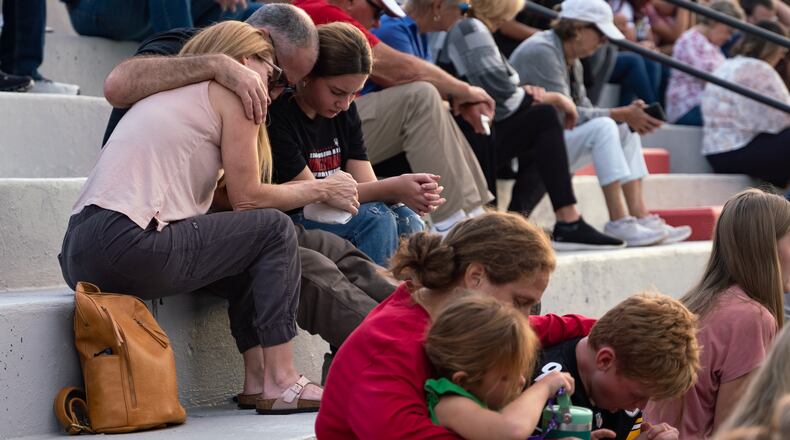“When we ran to our cubbies to hide, I remember thinking, you know, I should hide to the back of the classroom, to the other side, so that I don’t get shot.”
— Child victim, Sandy Hook Elementary School, 2012
No child should be shot to death in a classroom. This ruminated in my mind as I helped my 6-year-old grandson fill his backpack with new supplies — pencils, glue, paper — for his first day of first grade. I also placed another item in this bag: a Kevlar bulletproof shield that I tucked into the largest compartment of his backpack. We practiced that when (not if) his school announced a sudden lockdown or active-shooter drill, he would put his backpack on in the front or back depending on which way his body faced toward the classroom door.
Credit: Kay Hinton
Credit: Kay Hinton
That first day, he hopped on the bus with other excited children while an anxious dread colored my joy.
The recent school shooting at Apalachee High School in Winder, Georgia, exposes — again — our communities’ vulnerabilities. Mass casualty shootings, of course, are not confined to schools. Many people secretly pay attention to exits in hospitals, shopping centers, clubs, concert venues and places of worship in the event we hear the sickening sound of gunfire. Many of us, in our own way, imagines what we might do should it happen to us.
You might mentally practice the run-hide-fight protocol recommended by the Federal Emergency Management Agency. You might buy up personal protection devices like Kevlar shields and backpacks. We invent individual solutions in anticipation of danger. And yet, as a society, we are far from inventing comprehensive system-level solutions for an issue that is bigger than all of us.
Death and injury statistics are sobering and clear: Gun violence climbs year after year as we passively observe lives lost. About one third of K-12 parents are “very” or “extremely” worried that a shooting might happen at their child’s school. We have reason to be concerned: The number of children and teens killed by gun violence rose by 50% between 2019 and 2021 alone, according to the Centers for Disease Control and Prevention.
And it would seem I am not the only grandmother taking measures to protect a child. In 2019, CNN reported that sales for bulletproof backpacks surged 200% to 300% after mass shootings. Interest and costs have continued to climb since then.
Each shooting renews the fear that another one is coming, and, inevitably, it does, as we witnessed in Winder. Fear of the “unknown” and memories from recent shootings contribute to anxiety, trauma and a range of health effects among children. As a pediatric nurse practitioner, I can attest to the many ways gun violence impacts children’s learning, growth and development.
Put simply, gun violence is a public health problem — and solutions to public health problems require understanding of population-level issues. But our nation’s problem with gun violence is not easily understood. We point fingers in all directions by blaming mental health, guns, politicians. The truth is that there are many root causes for gun violence, and we need to study all of them.
Herein lies our quandary: Though we can track who was injured and who died, we lack other important data, such as the characteristics of shooters and victims, social context for the crime, types of guns employed and more. One looming barrier to studying this national plague? Limitations on government-funded research.
For too long, as scientists and clinicians, we have been prohibited from using government funds to study what some interpret as “gun control.” For two decades, gun injury prevention research was sidelined by the 1997 Dickey Amendment, clarified in 2018 to allow more funding to be used for research. Answering fundamental public health questions related to an issue that killed nearly 43,000 people in 2023 alone is not “control.” It’s common sense.
Let’s retire the term “gun control” and replace it with wider, solutions-based terms. Let’s call it what it is: “gun responsibility,” “gun safety” and “gun accountability.” Let us come together in a single voice, no matter our political bents and views, to stand in a unified body, to do right for those who have lost their lives because of gun violence. Our call to action is to show up to be witness to these avoidable losses by demanding adequate study of gun violence in the United States while purposely advocating for greater responsibility and accountability. We need to show up by reaching out to speak and write to our government representatives with action ideas designed to reduce harm from gun violence.
Without systems-level data to intricately expose previously unseen characteristics of shooters, weapons and gun casualty events, we will remain mired — trapped in repeated cycles of violence and inaction. To implement bipartisan, science-informed protections, we need insights. Without the right data, the responsibility will continue to fall on grandparents to purchase bullet-resistant materials to protect our children.
Sharron M. Close is a pediatric nurse practitioner and clinical professor at Emory’s Nell Hodgson Woodruff School of Nursing and a leading voice on gun safety and the public health implications of gun violence.
About the Author
Keep Reading
The Latest
Featured



